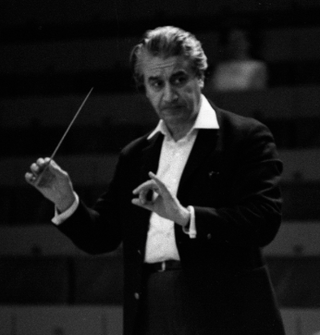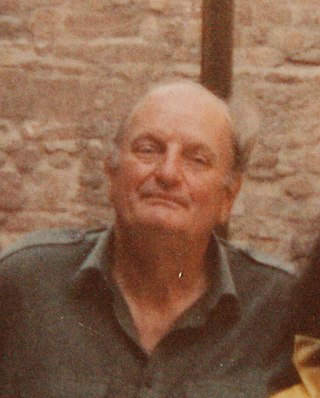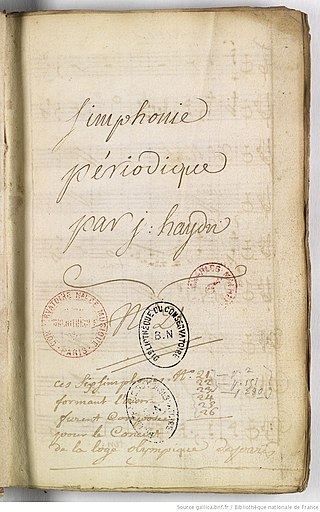
Sergiu Celibidache was a Romanian conductor, composer, musical theorist, and teacher. Educated in his native Romania, and later in Paris and Berlin, Celibidache's career in music spanned over five decades, including tenures as principal conductor of the Munich Philharmonic, Berlin Philharmonic, Sicilian Symphony Orchestra and several other European orchestras. Later in life, he taught at Mainz University in Germany and the Curtis Institute of Music in Philadelphia, Pennsylvania.

Howard Chandler Robbins Landon was an American musicologist, journalist, historian and broadcaster, best known for his work in rediscovering the huge body of neglected music by Haydn and in correcting misunderstandings about Mozart.

Johann Peter Salomon was a German violinist, composer, conductor and musical impresario. Although he was an accomplished violinist, he is best known for bringing Joseph Haydn to London and for conducting the symphonies that Haydn wrote during his stay in England. He also knew and worked with Wolfgang Amadeus Mozart and Ludwig van Beethoven.

The Symphony No. 25 in G minor, K. 183/173dB, was written by the then 17-year-old Wolfgang Amadeus Mozart in October 1773, shortly after the success of his opera seria Lucio Silla. It was supposedly completed in Salzburg on October 5, a mere two days after the completion of his Symphony No. 24, although this remains unsubstantiated. Its first movement was used as the opening music in Miloš Forman's film biographical Amadeus.

The Seasons is a secular oratorio by Joseph Haydn, first performed in 1801.
Symphony No. 103 in E♭ major is the eleventh of the twelve London symphonies written by Joseph Haydn. This symphony is nicknamed The Drumroll after the long roll on the timpani with which it begins. It is from 1795, and his second-to-last symphony.

Great Mass in C minor, K. 427/417a, is the common name of the musical setting of the mass by Wolfgang Amadeus Mozart, which is considered one of his greatest works. He composed it in Vienna in 1782 and 1783, after his marriage, when he moved to Vienna from Salzburg. The large-scale work, a missa solemnis, is scored for two soprano soloists, a tenor and a bass, double chorus and large orchestra. It remained unfinished, missing large portions of the Credo and the complete Agnus Dei.

The Symphony No. 101 in D major is the ninth of the twelve London symphonies written by Joseph Haydn. It is popularly known as The Clock because of the "ticking" rhythm throughout the second movement.
Friedrich Jeremias Witt was a German composer and cellist. He is perhaps best known as the likely author of a Symphony in C major known as the Jena Symphony, once attributed to Ludwig van Beethoven.
The Symphony No. 98 in B♭ major, Hoboken I/98, is the sixth of the twelve London symphonies composed by Joseph Haydn. It was completed in 1792 as part of the set of symphonies composed on his first trip to London. It was first performed at the Hanover Square Rooms in London on 2 March 1792. Some musicologists and historians interpret this symphony as Haydn’s tribute to his friend Mozart who had died on 5 December 1791.

The Symphony No. 3 in E♭ major, K. 18, formerly misattributed to Wolfgang Amadeus Mozart, is a symphony composed by Carl Friedrich Abel, a leading German composer of the earlier Classical period.

The Paris symphonies are a group of six symphonies written by Joseph Haydn commissioned by the Count D'Ogny, Grandmaster of the Masonic Loge Olympique. Beginning on 11 January 1786, the symphonies were performed by the Olympique in the Salle des Gardes du Corps of the Tuileries, conducted by Saint-Georges.

The Cello Concerto Nr. 1 in C Major (Op.4) is a cello concerto by Antonín Kraft.
The Symphony No. 75 in D major is a symphony composed by Joseph Haydn between 1779 and 1781.

The Symphony No. 52 in C minor is one of the last Sturm und Drang symphonies composed by the Austrian composer Joseph Haydn while the composer was in residence at Esterházy in 1771 or 1772.
The Symphony No. 53 in D major, Hoboken I/53, is a symphony by Joseph Haydn. It is often referred to by the subtitle "L'Impériale". The symphony was composed by 1777. It is scored for flute, two oboes, bassoon, two horns, timpani, and strings.

Joseph Haydn's Symphony No. 27 in G major was probably written before March 19, 1761, while he was employed by Count Morzin. Its chronological position was assigned by Eusebius Mandyczewski in 1907. Although later adopted by Hoboken, Robbins Landon has subsequently revised the work's likely chronological position and now believes that the symphony is one of Haydn's earliest, written at roughly the same time as symphonies nos. 15–18. Haydn himself may have labeled the symphony his 16th, although this remains unclear.

Joseph Haydn's Symphony No. 29 in E major, Hoboken I/29, was written in 1765, just after his 28th, and to be performed in Eisenstadt, under the benign auspices of Prince Nikolaus Esterházy.

Joseph Haydn's Symphony No. 11 in E♭ major is a symphony which may have been written as early as 1760 but no later than 1762, meaning that it was written for either the orchestra of the salubrious Count Morzin or the noble Paul II Anton, Prince Esterházy's palace in Eisenstadt.
Friedrich Wilhelm Stein was a German theologian, conductor, musicologist and church musician. He found in an archive in Jena the score of the so-called Jena Symphony, which he published as possibly a work by the young Ludwig van Beethoven. After a long period in Kiel from 1919 to 1933, teaching at the Kiel University and as Generalmusikdirektor, he had a leading position in the Reichsmusikkammer of the Nazis in Berlin.














